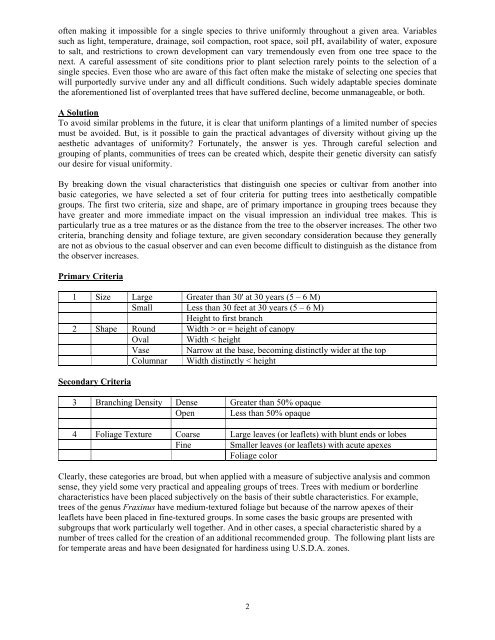Cold Hardy to Zone
Cold Hardy to Zone
Cold Hardy to Zone
- No tags were found...
You also want an ePaper? Increase the reach of your titles
YUMPU automatically turns print PDFs into web optimized ePapers that Google loves.
often making it impossible for a single species <strong>to</strong> thrive uniformly throughout a given area. Variablessuch as light, temperature, drainage, soil compaction, root space, soil pH, availability of water, exposure<strong>to</strong> salt, and restrictions <strong>to</strong> crown development can vary tremendously even from one tree space <strong>to</strong> thenext. A careful assessment of site conditions prior <strong>to</strong> plant selection rarely points <strong>to</strong> the selection of asingle species. Even those who are aware of this fact often make the mistake of selecting one species thatwill purportedly survive under any and all difficult conditions. Such widely adaptable species dominatethe aforementioned list of overplanted trees that have suffered decline, become unmanageable, or both.A SolutionTo avoid similar problems in the future, it is clear that uniform plantings of a limited number of speciesmust be avoided. But, is it possible <strong>to</strong> gain the practical advantages of diversity without giving up theaesthetic advantages of uniformity? Fortunately, the answer is yes. Through careful selection andgrouping of plants, communities of trees can be created which, despite their genetic diversity can satisfyour desire for visual uniformity.By breaking down the visual characteristics that distinguish one species or cultivar from another in<strong>to</strong>basic categories, we have selected a set of four criteria for putting trees in<strong>to</strong> aesthetically compatiblegroups. The first two criteria, size and shape, are of primary importance in grouping trees because theyhave greater and more immediate impact on the visual impression an individual tree makes. This isparticularly true as a tree matures or as the distance from the tree <strong>to</strong> the observer increases. The other twocriteria, branching density and foliage texture, are given secondary consideration because they generallyare not as obvious <strong>to</strong> the casual observer and can even become difficult <strong>to</strong> distinguish as the distance fromthe observer increases.Primary Criteria1 Size Large Greater than 30' at 30 years (5 – 6 M)Small Less than 30 feet at 30 years (5 – 6 M)Height <strong>to</strong> first branch2 Shape Round Width > or = height of canopyOval Width < heightVase Narrow at the base, becoming distinctly wider at the <strong>to</strong>pColumnar Width distinctly < heightSecondary Criteria3 Branching Density Dense Greater than 50% opaqueOpen Less than 50% opaque4 Foliage Texture Coarse Large leaves (or leaflets) with blunt ends or lobesFine Smaller leaves (or leaflets) with acute apexesFoliage colorClearly, these categories are broad, but when applied with a measure of subjective analysis and commonsense, they yield some very practical and appealing groups of trees. Trees with medium or borderlinecharacteristics have been placed subjectively on the basis of their subtle characteristics. For example,trees of the genus Fraxinus have medium-textured foliage but because of the narrow apexes of theirleaflets have been placed in fine-textured groups. In some cases the basic groups are presented withsubgroups that work particularly well <strong>to</strong>gether. And in other cases, a special characteristic shared by anumber of trees called for the creation of an additional recommended group. The following plant lists arefor temperate areas and have been designated for hardiness using U.S.D.A. zones.2
















